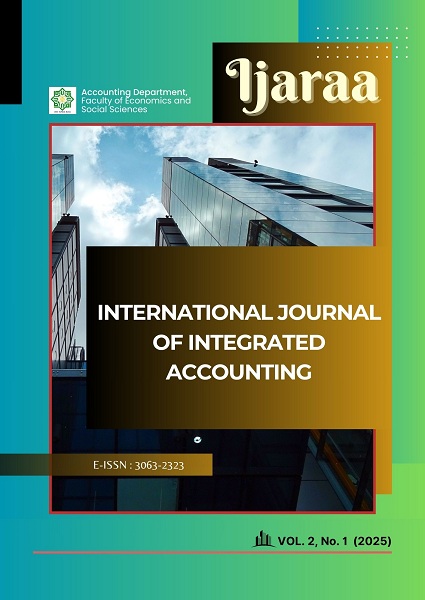Perceived Collective Efficacy Among Groups: Bridging Budget Control System with Team Effectiveness in University
Keywords:
Budget Control System, Perceived Collective Efficacy, Team EffectivenessAbstract
This study examines the role of perceived collective efficacy as a mediating variable between a university's budget control system and team effectiveness. The research employs a quantitative approach, utilizing quantitative assessments to evaluate the impact of the budget control system on perceived collective efficacy and team effectiveness. Findings indicate that the budget control system is positively related to the perceived collective efficacy and team effectiveness. Besides, the perceived collective efficacy is associated with team effectiveness and significantly mediates between a budget control system and team effectiveness. This research aligns with existing literature highlighting the critical mediating role of perceived collective efficacy in the relationship between budget control systems and team effectiveness. By fostering an environment conducive to collective efficacy, organizations may better leverage team dynamics to enhance overall performance outcomes, paving the way for future research to explore these interconnections within diverse contexts further
Downloads
References
Adhikari, P. R. (2020). Impact of Teamwork on Organizational Productivity in Nepalese Commercial Banks. Management Dynamics, 23(2), 75–84. https://doi.org/10.3126/md.v23i2.35810
Akhtar, M. W., Aslam, M. K., Huo, C., Akbar, M., Afzal, M. U., & Rafiq, M. (2022). The Interplay of Authentic Leadership and Social Capital on Team Leader Performance in Public and Private Sector Universities. Kybernetes, 52(6), 2045–2060. https://doi.org/10.1108/k-06-2021-0446
Bandura, A. (2000). Exercise of Human Agency Through Collective Efficacy. Current Directions in Psychological Science, 9(3), 75–78. https://doi.org/10.1111/1467-8721.00064
Bossche, P. V. d., Gijselaers, W., Segers, M., Woltjer, G., & Kirschner, P. A. (2010). Team Learning: Building Shared Mental Models. Instructional Science, 39(3), 283–301. https://doi.org/10.1007/s11251-010-9128-3
Bouteraa, M. (2024). Does Consumer Religiosity Matter for Green Banking Adoption? Evidence From a Muslim-Majority Market. Journal of Islamic Marketing, 15(7), 1807–1823. https://doi.org/10.1108/jima-02-2023-0049
Bradford, S. (2011). Leadership, Collective Efficacy and Team Performance. International Journal of Web-Based Learning and Teaching Technologies, 6(3), 35–45. https://doi.org/10.4018/jwltt.2011070103
Bruton, A. M., Mellalieu, S. D., & Shearer, D. A. (2014). Observation Interventions as a Means to Manipulate Collective Efficacy in Groups. Journal of Sport and Exercise Psychology, 36(1), 27–39. https://doi.org/10.1123/jsep.2013-0058
Chou, H.-W., Lin, Y., Chang, H.-H., & Chuang, W.-W. (2013). Transformational Leadership and Team Performance. Sage Open, 3(3). https://doi.org/10.1177/2158244013497027
Cools, M., Stouthuysen, K., & Abbeele, A. V. d. (2017). Management Control for Stimulating Different Types of Creativity: The Role of Budgets. Journal of Management Accounting Research, 29(3), 1–21. https://doi.org/10.2308/jmar-51789
Courtright, S. H., McCormick, B. W., Mistry, S., & Wang, J. (2017). Quality Charters or Quality Members? A Control Theory Perspective on Team Charters and Team Performance. Journal of Applied Psychology, 102(10), 1462–1470. https://doi.org/10.1037/apl0000229
Curtis, E. M., & Sweeney, B. (2019). Flexibility and Control in Managing Collaborative and in-House NPD. Journal of Accounting & Organizational Change, 15(1), 30–57. https://doi.org/10.1108/jaoc-07-2017-0057
Elhamma, A. (2015). The Relationship Between Budgetary Evaluation, Firm Size and Performance. The Journal of Management Development, 34(8), 973–986. https://doi.org/10.1108/jmd-06-2014-0053
Elms, A. K., Gill, H., & González‐Morales, M. G. (2022). Confidence Is Key: Collective Efficacy, Team Processes, and Team Effectiveness. Small Group Research, 54(2), 191–218. https://doi.org/10.1177/10464964221104218
Goddard, R. D. (2001). Collective Efficacy: A Neglected Construct in the Study of Schools and Student Achievement. Journal of Educational Psychology, 93(3), 467–476. https://doi.org/10.1037/0022-0663.93.3.467
Guidetti, G., Viotti, S., Bruno, A., & Converso, D. (2018). Teachers' Work Ability: A Study of Relationships Between Collective Efficacy and Self-Efficacy Beliefs. Psychology Research and Behavior Management, 11, 197–206. https://doi.org/10.2147/prbm.s157850
Haq, W., Raza, S. H., Said, F., & Ali, M. (2021). Covid-19 and Lockdown: Socio-Psychological Effects in Pakistan. https://doi.org/10.3390/ecerph-3-09048
Hart, P. S., Feldman, L., Choi, S., Zhang, A. L., & Hegland, A. (2023). The Influence of Flooding Imagery and Party Cues on Perceived Threat, Collective Efficacy, and Intentions for Political Action to Address Climate Change. Science Communication, 45(5), 627–664. https://doi.org/10.1177/10755470231199972
Hendri, J. (2006). Management control systems and strategy: a resource-based perspective. Accounting, Organizations and Society, 31, 529–558.
Henseler, J., Ringle, C. M., & Sarstedt, M. (2014). A New Criterion for Assessing Discriminant Validity in Variance-Based Structural Equation Modeling. Journal of the Academy of Marketing Science, 43(1), 115–135. https://doi.org/10.1007/s11747-014-0403-8
Herath, H. P. M. C. T., & Rathnasiri, R. A. (2021). Impact of Team Effectiveness on Organizational Performance: Special Reference to Apparel Manufacturing Firms in North Western Province. Wayamba Journal of Management, 12(2), 45. https://doi.org/10.4038/wjm.v12i2.7531
Hess, J. P. (2018). Autonomous Team Members' Expectations for Top-Leader Involvement. Team Performance Management, 24(5/6), 283–297. https://doi.org/10.1108/tpm-10-2017-0060
Hill, N. S., & Bartol, K. M. (2015). Empowering Leadership and Effective Collaboration in Geographically Dispersed Teams. Personnel Psychology, 69(1), 159–198. https://doi.org/10.1111/peps.12108
Hipp, J. R. (2016). Collective Efficacy: How Is It Conceptualized, How Is It Measured, and Does It Really Matter for Understanding Perceived Neighborhood Crime and Disorder? Journal of Criminal Justice, 46, 32–44. https://doi.org/10.1016/j.jcrimjus.2016.02.016
Hipp, J. R., & Wickes, R. (2018). Problems, Perceptions and Actions: An Interdependent Process for Generating Informal Social Control. Social Science Research, 73, 107–125. https://doi.org/10.1016/j.ssresearch.2018.03.015
HochiI, Y., MizunoO, M., Nakayama, T., Kanneko, I., & Kitamura, K. (2012). Relationship Between Collective Efficacy and Contextual Performance Among University Athletes in Japan. Work, 41(S1), 5759–5761. https://doi.org/10.3233/wor-2012-0942-5759
Huang, C.-Y., Huang, J., & Chang, Y. (2017). Team Goal Orientation Composition, Team Efficacy, and Team Performance: The Separate Roles of Team Leader and Members. Journal of Management & Organization, 25(6), 825–843. https://doi.org/10.1017/jmo.2016.62
Ibeabuchi, C., Ehido, A., Fawehinmi, O., & Aigbogun, O. (2024). Determinants of Purchase Intention Towards Halalcertified Cosmetic Products Among nonMuslims. Journal of Islamic Marketing, 15(12), 3778–3803. https://doi.org/10.1108/jima-09-2022-0255
Iqbal, S., Martins, J. M., Mata, M. N., Naz, S., Akhtar, S., & Abreu, A. (2021). Linking Entrepreneurial Orientation With Innovation Performance in SMEs; The Role of Organizational Commitment and Transformational Leadership Using Smart PLS-SEM. Sustainability, 13(8), 4361. https://doi.org/10.3390/su13084361
Jawad, S., Ledwith, A., & Panahifar, F. (2018). Enablers and Barriers to the Successful Implementation of Project Control Systems in the Petroleum and Chemical Industry. International Journal of Engineering Business Management, 10. https://doi.org/10.1177/1847979017751834
Jurado, M. del M. M., Fuentes, M. del C. P., Atria, L. F., Ruíz, N. F. O., & Linares, J. J. G. (2019). Burnout, Perceived Efficacy, and Job Satisfaction: Perception of the Educational Context in High School Teachers. Biomed Research International, 2019, 1–10. https://doi.org/10.1155/2019/1021408
Kathuria, R., & Davis, E. B. (2001). Quality and work force management practices: the managerial performance implication. Production and Operations Management, 10, 460–477.
Kemunto, D., & Cheluget, J. (2022). Budgetary Controls and Financial Performance of Micro Finance Institutions (MFIs) in Kenya. Journal of Finance and Accounting, 6(4), 123–145. https://doi.org/10.53819/81018102t6045
Khalid, I., Ullah, S., Hasnain, R., & Ali, N. (2024). The Role of E-Leadership on Sustainable Employee Performance With the Mediating Effect of Perceived Team Dynamics and Moderating Effect of Organizational Support. CRSSS, 2(2), 37–50. https://doi.org/10.59075/xa66hh89
Khalifeh, C. J., & Sivabalan, P. (2014). An Experimental Study on the Effect of Budget Information on Balanced Scorecard Preparer Individual Learning. Australian Accounting Review, 24(1), 39–52. https://doi.org/10.1111/auar.12017
Kohlmeyer, J. M., Mahenthiran, S., Parker, R. J., & Sincich, T. (2014). Leadership, Budget Participation, Budgetary Fairness, and Organizational Commitment. 95–118. https://doi.org/10.1108/s1475-148820140000017003
Laitinen, E. K., Länsiluoto, A., & Salonen, S. (2016). Interactive Budgeting, Product Innovation, and Firm Performance: Empirical Evidence From Finnish Firms. Journal of Management Control, 27(4), 293–322. https://doi.org/10.1007/s00187-016-0237-2
Lesorogol, N., Achimba, C., & Opondo, F. (2024). Budget Control on Capital Project Delivery in Samburu County Government. International Journal of Finance and Accounting, 9(4), 1–16. https://doi.org/10.47604/ijfa.2841
Li, J., Jia, L., Cai, Y., Kwan, H. K., & You, S. (2020). Employee–Organization Relationships and Team Performance: Role of Team Collective Efficacy. Frontiers in Psychology, 11. https://doi.org/10.3389/fpsyg.2020.00206
Li, W. (2024). Examining the Reliability and Validity of Measuring Scales Related to Informatization and Instructional Leadership Using the PLS-SEM Approach. Humanities and Social Sciences Letters, 12(3), 461–480. https://doi.org/10.18488/73.v12i3.3789
Li, Y. (2022). Design Visual Elements and Brand-Based Equity: Mediating Role of Green Concept. Frontiers in Psychology, 13. https://doi.org/10.3389/fpsyg.2022.888164
Liao, G., Jiao, Z., & Yin, J. (2022). Effect of Organizational Socialization of New Employees on Team Innovation Performance: A Cross-Level Model. Psychology Research and Behavior Management, Volume 15, 1017–1031. https://doi.org/10.2147/prbm.s359773
Linfang, Z., Khalid, R., Raza, M., Chanrawang, N., & Parveen, R. (2021). The Impact of Psychological Factors on Women Entrepreneurial Inclination: Mediating Role of Self-Leadership. Frontiers in Psychology, 12. https://doi.org/10.3389/fpsyg.2021.796272
López-Gajardo, M. Á., García‐Calvo, T., González‐Ponce, I., García, J. D., & Marcos, F. M. L. (2022). Cohesion and Collective Efficacy as Antecedents and Team Performance as an Outcome of Team Resilience in Team Sports. International Journal of Sports Science & Coaching, 18(6), 2239–2250. https://doi.org/10.1177/17479541221129198
Majeed, M., Irshad, M., Khan, I. U., & Saeed, I. (2023). The Impact of Team Mindfulness on Project Team Performance: The Moderating Role of Effective Team Leadership. Project Management Journal, 54(2), 162–178. https://doi.org/10.1177/87569728221140807
Manata, B., Miller, V. D., Mollaoglu, S., & Garcia, A. J. (2021). Documenting the Interactive Effects of Project Manager and Team-Level Communication Behaviors in Integrated Project Delivery Teams. Project Management Journal, 53(1), 33–48. https://doi.org/10.1177/87569728211047296
Marcos, F. M. L., Filho, E., López-Gajardo, M. Á., García‐Calvo, T., & González‐Ponce, I. (2022). The Relationship Among Intra‐group Communication, Transactive Memory Systems, Collective Efficacy and Team Performance: A Structural Equation Model Analysis With Elite Footballers. European Journal of Sport Science, 23(4), 599–606. https://doi.org/10.1080/17461391.2022.2049373
Mash, H. B. H., Fullerton, C. S., Morganstein, J. C., Vance, M. C., Wang, L., Liu, A., Mullins-Hussain, B., & Ursano, R. J. (2021). Longitudinal Study of Hurricane Preparedness Behaviors: Influence of Collective Efficacy. Disaster Medicine and Public Health Preparedness, 16(3), 1046–1052. https://doi.org/10.1017/dmp.2020.504
Matsoso, M. L., Nyathi, M., & Nakpodia, F. (2021). An Assessment of Budgeting and Budgetary Controls Among Small and Medium-Sized Enterprises: Evidence From a Developing Economy. Journal of Accounting in Emerging Economies, 11(4), 552–577. https://doi.org/10.1108/jaee-04-2020-0082
Miyao, M., Ozaki, H., Tobia, S., Petruzzelli, A. M., & Frattini, F. (2022). The Role of Open Innovation Hubs and Perceived Collective Efficacy on Individual Behaviour in Open Innovation Projects. Creativity and Innovation Management, 31(2), 294–305. https://doi.org/10.1111/caim.12494
Naseem, K., & Ali, M. (2023). Impact of Work Demand Constraints on Psychological Distress Through Workplace Bullying and Personality Traits: A Moderated-Mediation Model. Frontiers in Psychology, 13. https://doi.org/10.3389/fpsyg.2022.965835
Pattisahusiwa, S., Musviyanti, M., & Lahaya, I. A. (2019). Is Inefficiency Still a Major Problem in Regional Spending and How to Overcome It? (Case Study of East Kalimantan Province). https://doi.org/10.2991/teams-18.2019.38
Pereira, M. M., Coelho, L. L. G. de A., Silva, G. L. d., & Cunha, Y. S. A. (2019). Application of Statistical Analysis to Improve Time Management of a Process Modeling Project. Gestão & Produção, 26(4). https://doi.org/10.1590/0104-530x3945-19
Rice, L. J., Hughes, B., Briggs, V., Delmoor, E., Jefferson, M., Johnson, J., & Halbert, C. H. (2015). Perceived Efficacy and Control for Neighborhood Change: The Cross-Cutting Role of Collective Efficacy. Journal of Racial and Ethnic Health Disparities, 3(4), 667–675. https://doi.org/10.1007/s40615-015-0185-9
Salanova, M., Liorens, S., Cifre, E., Martinez, I. M., & Schaufeli, W. B. (2003). Perceived collective efficacy, subjective well-being and task performance among electronic work groups: an experimental study. Small Group Research, 34, 43–73.
Saraswati, A. E., & Setiyawati, H. (2021). Factors Affecting the Control of Budget Abuse. Journal of Contemporary Accounting, 3(2), 88–97. https://doi.org/10.20885/jca.vol3.iss2.art4
Schreuder, F., Schalk, R., & Batistič, S. (2019). Goal Congruence in Teams and Performance: The Role of (Shared) Psychological Contract Fulfilment. Journal of Management & Organization, 29(1), 86–102. https://doi.org/10.1017/jmo.2019.52
Seftyandra, F., & Arviansyah, A. (2020). Key Indicators Influencing Team Effectiveness in Project-Based Team. Kne Social Sciences. https://doi.org/10.18502/kss.v4i3.6395
Shanmugapriya, S., & Subramanian, K. R. (2015). Structural Equation Model to Investigate the Factors Influencing Quality Performance in Indian Construction Projects. Sadhana, 40(6), 1975–1987. https://doi.org/10.1007/s12046-015-0421-3
Shi, S., Zhao, F., Zhang, H., Li, H., & Ye, X. (2023). Research on the Influences of Task Interdependence on Team Performance in the Context of the Leader–Member Exchange Differentiation in the Public–Private Partnership Projects. Sustainability, 15(18), 13429. https://doi.org/10.3390/su151813429
Shih, C. P., & Putri, D. U. (2016). Measuring the Effect of Team Characteristics, Team Effectiveness on Organizational Performance, Organizational Survival and Competitiveness. International Journal of Asian Business and Information Management, 7(2), 1–14. https://doi.org/10.4018/ijabim.2016040101
Simanjuntak, A., Siahaan, S. B., Situmorang, D. R., & Elisabeth, D. M. (2023). Factors Affecting Accountability Government Institution Performance. Accounting Analysis Journal, 12(2), 112–122. https://doi.org/10.15294/aaj.v12i2.61983
Tannenbaum, S. I., & Greilich, P. E. (2022). The Debrief Imperative: Building Teaming Competencies and Team Effectiveness. BMJ Quality & Safety, 32(3), 125–128. https://doi.org/10.1136/bmjqs-2022-015259
Umrani, W. A., Shah, S. M. M., Memon, P. A., & Samo, A. H. (2017). Organizational Culture and Business Performance: An Empirical Investigation in the Pakistani Context. International Journal of Academic Research in Economics and Management Sciences, 6(1). https://doi.org/10.6007/ijarems/v6-i1/2575
Wuarlela, Y. K., Assih, P., & Parawiyati, P. (2023). The Effect of Government Internal Control Systems and Organizational Commitment on Organizational Performance Through Work Accountability as an Intervening Variable (Case Study on the Organization of the Regional Apparatus of the Tanimbar Islands Regency). Journal of Economics Finance and Management Studies, 06(06). https://doi.org/10.47191/jefms/v6-i6-07
Xie, Z., Wu, R., Liu, H., & Liu, J. (2022). How Does Teacher-Perceived Principal Leadership Affect Teacher Self-Efficacy Between Different Teaching Experiences Through Collaboration in China? A Multilevel Structural Equation Model Analysis Based on Threshold. Frontiers in Psychology, 13. https://doi.org/10.3389/fpsyg.2022.933838
Zumeta, L., Oriol, X., Telletxea, S., Amutio, A., & Basabe, N. (2016). Collective Efficacy in Sports and Physical Activities: Perceived Emotional Synchrony and Shared Flow. Frontiers in Psychology, 6. https://doi.org/10.3389/fpsyg.2015.01960
Downloads
Published
Issue
Section
License
Copyright (c) 2025 Desi Ilona (Author)

This work is licensed under a Creative Commons Attribution-ShareAlike 4.0 International License.











